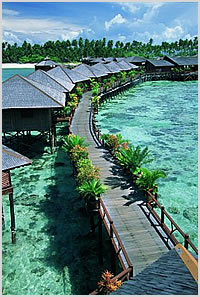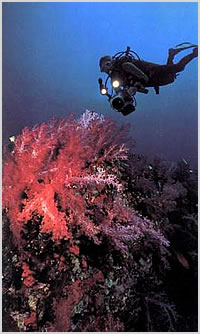By PHILIP GAME
A boom in luxury self-contained villa accommodation is leading Bali’s resurgence.
Villa developments march across the rice paddies of Seminyak, as self-contained villa accommodation leads Bali’s renaissance as a top-end destination.
Villas provide privacy, exclusivity and independence for those who know their way around Bali. Couples and groups can, by sharing, luxuriate in spa treatments, butler service or car and driver on call.
 The main pool at The Patra Bali Resort and Villas.
The main pool at The Patra Bali Resort and Villas. As discerning visitors forsake the all-night party scene, districts like Seminyak, well-supplied with shopping and fine dining, come to the fore; welcome surprises await further around the coast or inland at Ubud.
“Bali’s lifestyle these days is excellent, I rate it seven out of 10,” declares one expatriate hotelier.
He decries the alarmist travel warnings issued by foreign governments, pointing to the much-enhanced security measures encountered wherever foreigners gather — and to the economic vulnerability of innocent Balinese.
Villa properties range from simple, moderately priced bungalows, to sybaritic luxury. Most feature private garden compounds and their own swimming pool or plunge pool; most have fully equipped kitchens (staff on hand can shop and prepare meals).
Here’s what we found on a recent round-up of some villa properties:
The Elysian opened late 2005, near the Oberoi and Ku De Ta Restaurant in Seminyak: a secluded yet prestigious location, optimising a relatively compact site.
Twenty-six villas cluster around the common areas, which include a sun deck, 25-metre lap pool, library with Internet access and the 48-seat Rush Bamboo Restaurant, open all day. There’s a small meeting room and a gym is to follow.
Ambitious young French-born Benoit Amado, manager at the time of my visit, saw his target market as the 25- to 45-year-old sophisticated traveller who appreciates “affordable luxury” as a smaller-scale, more intimate alternative to the Aman properties or The Legian.
“We’ll give you an iPod, if you didn’t bring your own,” he declared, so the villas are fitted accordingly with docking stations.
 Puri Dajuma Cottages in Pekutatan, Bali. — PHILIP GAME, THE PATRA BALI RESORT AND VILLAS & VILLA DE DAUN
Puri Dajuma Cottages in Pekutatan, Bali. — PHILIP GAME, THE PATRA BALI RESORT AND VILLAS & VILLA DE DAUN The Elysian preserves a sense of privacy, of something different waiting to be discovered around every corner.
Verdict: top marks for style and exclusivity.
Villa de daun is a compact garden retreat in the heart of Kuta, tucked away behind the main shopping strip (although the beach is minutes away).
By anyone’s standards, the units, especially the premium Deluxe villas, are enticing, although some upgrading is now planned in the standard-grade Superior villas. Deluxe villas boast an attractive small library or study and a more spacious dining area.
Verdict: a stylish retreat for shopaholics.
The Patra Bali Resort and Villas could not be more different: a sprawling beachfront estate at Tuban, within sight and sound of the airport, where the former Pertamina Cottages once stood. This is now the newest and smartest complex in a district better known for big name hotel-style properties, asserts I Nyoman Sadia, director of sales, who also lays claim to Bali’s best-equipped kids’ club.
From an imposing three-storey lobby adorned with five-metre high murals, electric jeeps shuttle out to the beachfront villas, which enjoy exclusive use of their own pool.
Royal Villa units are sumptuous, although the décor is classic rather than cutting edge and some may find the abundance of varnished timber a little oppressive.
Club Suite villas, at the economy end of the scale, remain appealing.
Verdict: especially family friendly with its kids’ club, spacious lawns and beachfront setting.
Now for something totally different. Puri Dajuma Cottages is a group of comfortable but unpretentious villas grouped above a remote black sand beach in western Bali.
After a long drive dodging trucks and motorcycles on the main road from Denpasar to the Java ferry, then a detour down a narrow track, Puri Dajuma comes as a welcome surprise.
Gaily-painted prahu (outriggers) motor in to shore each morning; the fishermen and their families are as intrigued to meet you as you will be to meet them.
Around the bay awaits the renowned Medewi surf beach.
At US$85-US$95 (RM288-RM322), depending on sea views, rates are less than half those charged by fancier properties, but with Swiss-French management, the restaurant menu reveals a whiff of Gallic inspiration.
Verdict: a delightfully different slant on the Bali you thought you knew, and an ideal stopover on the overland journey to Java.
Popular with the girls
The Villas, Kuta’s first villa development, was the inspiration of Australian painter Jim Elliott around 15 years ago. The property is now as well known for its Prana and Chill Spas as for its accommodation.

The ambience is Marrakech-meets-maharaja, an orientalist’s daydream of spires, minarets, elephant gods and other exotica: no minimalism here. It’s not hard to see why Prana is especially popular with hen parties.
Each three-bedroom villa is arranged around a central pool, the living areas are open-plan and the entire property is tastefully decorated with Asian art.
Verdict: dream on, princess . . .
The writer travelled as a guest of all the properties mentioned.
FYI
Rates per villa typically range from US$220-US$300 (RM746-RM1,017) with 21% tax and service charges additional. A minimum of four, five or seven nights’ stay is required at many properties. Strict cancellation or loss of deposit policies may apply.



